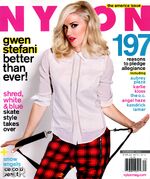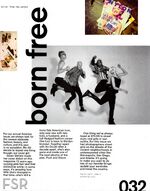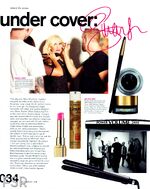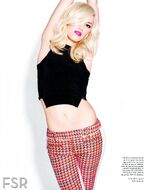On a sunny August morning , three-quarters of No Doubt sip coffee by a picture window in the Mandarin Oriental hotel’s lobby, so high above New York Cit’s Central Park that the trees appear thumb-sized. For three 40-something band mates releasing their first studio album in over a decade, bassist Tony Kanal, guitarist Tom Dumont, and drummer Adrian Young look remarkably unchanged — if anything their Mod-cut plaid suits and cartoonish hairdos are showing only a bit more polish. The band started work on their sixth studio album Push and Shove four years ago, and it turned out to be one of their hardest fought projects — creatively and logistically — ever. Not that you’d know it today.
“We’re going to make a country-western album next,” says Kanal. “I can feel it.” With a devilish grin, Young adds, “I don’t think there’s a genre we can’t conquer.” After a brief silence, Dumont weighs in. “You know what?” he says. “Jam music. I don’t think we could jam.” Sober nods all around and Kanal concedes: “You’re right. We couldn’t jam.”
A few hours later, and 20-odd blocks away, Gwen Stefani speeds through downtown Manhattan in a black SUV, surrounded by an amiable girl-gang of handlers. Rolling from the desolate west side of Chelsea to a noisy French bistro, Stefani chats merrily in her laid-back Cali-girl drawl perched in the vehicle’s center row. Wearing bright pink lipstick on her typically blood-red pout and a cut-out Yohji Yamamoto blazer over a baseball T-shirt, she explains the genesis of her assistant’s career (“I worked my way up from the mailroom,” the smiley Lizzie Barrois-Heron jokes) and gamely plays tour guide.
“This is where Kingston was conceived!” Stefani announces as we pass the Soho House on Ninth Avenue, referring to her six-year-old son with husband Gavin Rossdale of English band, Bush (they also have a four-year-old, Zuma). Everyone peers up at the private hotel as we pass by it, and Oooos collectively.
Waving a diamond-bedecked hand at this or that attraction outside the window, Stefani looks like a remixed silent-film star. In fact, she’s so often and so well photographed that she almost seems to move in a series of elegant, curated snapshots.
In 2008, No Doubt regrouped in Los Angeles to begin work on their next album for Interscope. They quickly hit a wall. Although they’d all essentially come of age together on a tour bus, as adults they were almost like alumni at a high school reunion. “A lot of our writing sessions would just be hanging out sessions,” says Dumont. “Hang out, shoot the shit. At a certain point when that comfort level crept in, we’d end up talking about music.”
They also needed a reminder that their own music was worth talking about. The band decided to go on a summer tour to get nightly confidence booster shots from screaming No Doubt fans. “By the time we got home, we had our first song, so it really did work,” says Kanal. “We had to get over that uncertainty of not knowing if what we were working on was good.” With a refreshed attitude, they returned to the studio and began collecting new No Doubt moments.
“The whole albums is capturing little sparks, little snapshots,” says Dumont. “You cast away all mediocre ones and keep the ones that are good.” For Stefani, there was a little bit more to the process.
Settled into a corner booth, her face frames by platinum blond locks, Stefani recalls her own additional preparation for the album: an inspiration party at her house in Beverly Hills. “I got all my favorite people that I work with [together] and we had a creative day,” says Stefani, naming a group that included Sophie Muller, stylists Andrea Lieberman and Paula Bradley, and fashion designer Jolie Clemens. “We basically all sat around with our art books and [magazine] tears and just put them up and did collages and tried to get a direction. We ended up not using anything,” she says with a slight sigh. “But it was really fun.”
In facet, collage may be the sole art form that could define Stefani’s life during the No Doubt hiatus. Stefani released two solo albums — Love.Angel.Music.Baby. and The Sweet Escape — that solidified her as a pop powerhouse. The former’s Neptune’s produced “Hollaback Girl” instantly joined the ranks of pop’s most inescapable, ridiculously irresistible hits and its video showcased Stefani’s fascination with the Harajuku culture. Her then-entourage of pint-sized, mean-mugging Japanese backup dancers established her as a kind of sunny, conceptual performing artist. “I wanted to [make a solo album] so bad but it was awful to be so vulnerable,” she said. “Then I just had this thought, Oh, if I do a record, maybe I could go back to Japan! I was always such a huge fan. When I went though the first time I was like, ‘I feel like I’m Japanese.’ Everything that they’re a fan of, I’m a fan of.”
The rest, she says, happened organically. “It wasn’t just like, ‘Ok! I found the FRUiTS book!”, she says, referencing the Harajuku street style bible and pretending to check one more item off an imaginary list. “Ok! I’m going to do a record!” She checks another.
The fashion line L.A.M.B. came next, in the spring of 2004, followed by the more casual brand Harajuku Lovers a year later. But while clothing and fragrance lines are requisite parts of today’s pop-star business plan, they’re palpably in Stefani’s DNA. Raised in a family of seamstresses, she sewed much of her early No Doubt stagewear and soon became a style icon on and off-stage — popularizing often unlikely fashion statements from Bindis to Chola-inspired exposed midriffs to ornamental braces. As her consistently bold choices showed fans her private obsessions, they joined a narrative of clothes, makeup, and hairstyles that were always as unpredictable as her music.
When No Doubt formed in Anaheim, California, in the late ’80s their influences were the English ska bands favored by Stefani’s older brother, Eric, No Doubt’s founding member (he later quit the band). They soon forged a distinct pop amalgam of fringe genres like Jamaican dancehall, So-Cal punk, and ’80s New Wave. But their hits came straight from the life of Eric’s little sister. Stefani wrote the No. 1 single “Don’t Speak”, from 1995′s Tragic Kingdom about — and during — her break-up with longtime boyfriend Kanal, her heartbreak going straight into the lyrics and performance that launched the band into Diamond-certified stardom.
This seems like it might have taken some nerve — writing a break-up song about a guy who’s in your band and making him play it beside you every night. Stefani assures me that it did. “I was pissed!” she recalls, leaning back on the banquette and scrunching up her face a little. “I was being dumped in front of everybody. And I just remember finding so much power in songwriting.” But she also found a remarkably amiable lyrical consultant in Kanal. “I would call him up and like, ‘Listen to this‘,” she says, of lyrics that foreshadowed their demise as a couple. “We were never bitter or mad, btu it was like, I can tell this is happening… is it really going to happen? How can you do this? We’re best friends, you know? But, it did, and thank God.” She brightens at this. “Or I wouldn’t have made all those songs.”
More than 15 years later, Push and Shove takes a few cues from adolescent melodrama. Instead, the new songs emerged from adult frustrations that kept the band apart: lack of time, lack of energy, too many commitments. While these topics don’t exactly suggest “killer pop album,” they’re only the latest of the emotional preoccupations this bad has found a way to turn into pop hooks. “I think it’s some of our best songwriting because of the experience we’ve had working with other people,” Stefani says. “Tony really came to the plate as a songwriter — he gave so much with lyrics and melodies. That was the first time we’d done it together,” says Stefani, sipping from a cup of tea. “And then Tom — he knows music. Me and Tony are just a series of accidents and mistakes trying to write new songs, we don’t know what we’re doing. So it was a good combination.”
The band enlisted Spike Stent (producer/mixer of 2001′s Rock Steady) to produce the album, turning out radio-ready tracks like reggae-ish album opening “Settle Down” and the chilled-out “Sparkle”. They also collaborated with Major Lazer and Busy Signal on the title track and first single. “They come from similar tastes as far as Jamaican roots,” says Stefani of the two, “and they sent this amazing track over. I love how that song turned out.” Regardless of tempo or instrumentation, the one constant on Push and Shove is Stefani’s preoccupation with change and the passing of time. “But you can see it in my eyes / You can read it on my lips,” Stefani wails on “Push and Shove”, [BSO Correction: "Settle Down"] “I’m trying to get a hold on this.”
No one can quite get a hold on the music business that exists after Rock Steady. No Doubt once ruled an era when music videos were only played and hungrily watched on TV, but when fans were even willing to sit through a 30-minute program documenting the making of said video. And photos of No Doubt on MTV Awards’ red carpets in the ’90s and early ’00s represent some of the most crucial moments in their evolution. (In particular, their performance on the balcony of Radio City Music Hall before the VMAs in 1996 — overlooking the red carpet.)
“I was thinking about that last night,” says Stefani. She picks up a bottle of sparkling water and refills both of our glasses. “It used to have so much weight. People even paid attention to the categories! Now if you win one — I don’t even think anyone takes your picture. It’s like, whatever.” Stefani welcomes today’s lower stakes. For the first Push and Shove video, the band hopped in a van, drove to Williamsburgh, Brooklyn, and shot footage for it in one night. “Then we’ll just put it [online] for the people that care,” says Stefani. “And that’s exciting. Before, it would take weeks and weeks — ‘Where’s the edit!?’ — and now you’re more in charge of your own world.”
As she says this, her phone lights up. She smiles, picks it up, and shows me another rare significant factor in the life of today’s No Doubt. It’s a texted photo of Kingston standing on a New York City street corner, possibly quite nearby. Seeing his cute pose, I start to feel a little guilty for hogging her time, knowing that it’s exactly this titular “push and shove” — of work and life — that drove No Doubt’s latest album.
“It’s always something,” Stefani says, dismissing my concerns with a shrug. “With Tragic Kingdom it was about the breakup and my brother leaving the band. With Return of Saturn it was ‘Oh my God, who am I now?’ With Rock Steady that pressure was gone and we made a really fun record. Now it’s like, ‘How are we going to do this? It’s not the same anymore.’”
Of course, nothing can ever be the same as the giddy first chapter of No Doubt’s reign. Sitting with her manicured hands resting on her lap, Stefani summons the first tremors that announced the band’s imminent success. “There were times when you could feel it happening in our small pond,” she says. “I remember walking into Tower Records, and I could hear people snickering, ‘That’s No Doubt.’” Then came the discovery that she was a natural-born show woman. “There was this powerful performance where I was like, Wow, I really feel this now,” she says. “I’m really becoming different. I remember it changing.” Then came the realization that she could write songs — beginning with 1995′s spunky and defiant “Just a Girl.” “When we played it live you could tell that it was bubbling,” she says. “And that whole year before Tragic Kingdom came out, you could just feel something happening.” But there’s certainly no way that Stefani ever could have predicted how far from Orange County the music would ultimately take them or the perspective it leaves her with today.
“I’m telling you right now,” she says, leaning forward and swirling a spoon in her tea, “being Number One or playing in the garage — they’re both super fun.”







